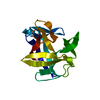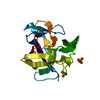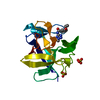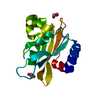Entry Database : PDB / ID : 2kxqTitle Solution Structure of Smurf2 WW2 and WW3 bound to Smad7 PY motif containing peptide E3 ubiquitin-protein ligase SMURF2 Smad7 PY motif containing peptide Keywords / / / / / Function / homology Function Domain/homology Component
/ / / / / / / / / / / / / / / / / / / / / / / / / / / / / / / / / / / / / / / / / / / / / / / / / / / / / / / / / / / / / / / / / / / / / / / / / / / / / / / / / / / / / / / / / / / / / / / / / / / / / / / / / / / / / / / / / / / / / / / / / / / / / / / / / / / / / / / Biological species Homo sapiens (human)Method Authors Chong, A. / Lin, H. / Wrana, J. / Forman-Kay, J.D. Journal : Proc.Natl.Acad.Sci.USA / Year : 2010Title : Coupling of tandem Smad ubiquitination regulatory factor (Smurf) WW domains modulates target specificity.Authors : Chong, P.A. / Lin, H. / Wrana, J.L. / Forman-Kay, J.D. History Deposition May 11, 2010 Deposition site / Processing site Revision 1.0 Oct 13, 2010 Provider / Type Revision 1.1 Jul 13, 2011 Group Revision 1.2 Jun 20, 2012 Group Revision 1.3 May 1, 2024 Group / Database referencesCategory chem_comp_atom / chem_comp_bond ... chem_comp_atom / chem_comp_bond / database_2 / struct_ref_seq_dif Item / _database_2.pdbx_database_accession / _struct_ref_seq_dif.details
Show all Show less
 Yorodumi
Yorodumi Open data
Open data Basic information
Basic information Components
Components Keywords
Keywords Function and homology information
Function and homology information Homo sapiens (human)
Homo sapiens (human) Authors
Authors Citation
Citation Journal: Proc.Natl.Acad.Sci.USA / Year: 2010
Journal: Proc.Natl.Acad.Sci.USA / Year: 2010 Structure visualization
Structure visualization Molmil
Molmil Jmol/JSmol
Jmol/JSmol Downloads & links
Downloads & links Download
Download 2kxq.cif.gz
2kxq.cif.gz PDBx/mmCIF format
PDBx/mmCIF format pdb2kxq.ent.gz
pdb2kxq.ent.gz PDB format
PDB format 2kxq.json.gz
2kxq.json.gz PDBx/mmJSON format
PDBx/mmJSON format Other downloads
Other downloads 2kxq_validation.pdf.gz
2kxq_validation.pdf.gz wwPDB validaton report
wwPDB validaton report 2kxq_full_validation.pdf.gz
2kxq_full_validation.pdf.gz 2kxq_validation.xml.gz
2kxq_validation.xml.gz 2kxq_validation.cif.gz
2kxq_validation.cif.gz https://data.pdbj.org/pub/pdb/validation_reports/kx/2kxq
https://data.pdbj.org/pub/pdb/validation_reports/kx/2kxq ftp://data.pdbj.org/pub/pdb/validation_reports/kx/2kxq
ftp://data.pdbj.org/pub/pdb/validation_reports/kx/2kxq Links
Links Assembly
Assembly
 Components
Components Homo sapiens (human) / Gene: SMURF2 / Plasmid: PGEX6P1 / Production host:
Homo sapiens (human) / Gene: SMURF2 / Plasmid: PGEX6P1 / Production host: 
 Homo sapiens (human) / Gene: Smad7 / Plasmid: PGEX6P1 / Production host:
Homo sapiens (human) / Gene: Smad7 / Plasmid: PGEX6P1 / Production host: 
 Sample preparation
Sample preparation Processing
Processing Movie
Movie Controller
Controller












 PDBj
PDBj










